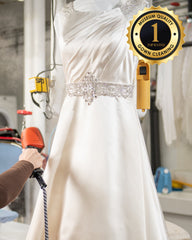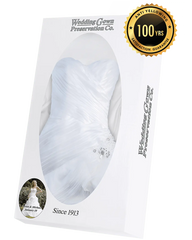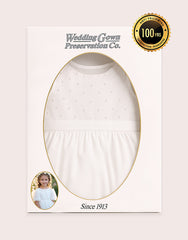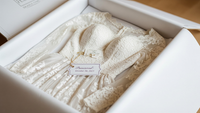If you intend to keep the wedding gown for posterity, preservation is the best means to this end. Regular gown cleaning will not suffice. You need to go above and beyond to ensure the gown is pristinely cleaned, in good condition, and crucially, stored in the right conditions. However, if your gown starts to yellow, you can still restore the dress to a good as new conditions.
What Is Wedding Dress Preservation And Restoration?

Unfortunately, many are the times brides forget to take their wedding gowns for specialized treatment early enough. It is common for brides to wait for up to 6 weeks before taking their gown for cleaning. This long wait gives the soiling ample time to set in and create lasting stains. When the stains have set in, the best course of action is a restoration project.
Wedding Dress Cleaning Vs. Wedding Dress Preservation/Restoration?
Typical dry-cleaning does not account for each wedding gown's uniqueness, such as the details, stitching, and the fabric. Instead, they use normal cleaning processes as they would with other types of clothes. This is not enough to keep the wedding dress in pristine condition for years or decades in almost all cases.
Also Read: 4 Reasons Why You Should Preserve Your Wedding DressWhile cleaning is part and parcel of wedding preservation, the preservation or restoration process is intricate and more involving. Crucially, after the gown has gone through the specialized cleaning process, the preservation specialist will package the dress to ensure it is well protected. This process allows brides to preserve their gowns for posterity.
What Causes Fabric To Yellow Over Time?

Fabric yellowing is a common phenomenon for white fabrics. One of the most common causes of yellowing is fiber degradation. Once the fibers begin to break down chemically, they change color from the white color to a light yellow, which inevitably turn to deep yellow. Additionally, the decomposition of any contaminant on the fabric can cause long-lasting stains such as brown stains from sugary stains or red stains from red wine to form. Brown stains are common for stains formed from sugar breakdown.
Also Read: 7 Essential Tips in Storing Your Wedding Dress
Atmospheric contaminants such as nitrogen oxides and transferred contaminants are also a significant cause of concern regarding wedding dresses yellowing.
The yellowing process starts in as little as 6 months. Left unattended, gowns made of fabrics such as chiffon and satin will attain a dull yellow shade that gets more intense over time. Unseen stains are common, and they cause brown spots to form, sometimes much earlier than 6 months. Moreover, when you store the dress in a hot, humid, or expose the dress to direct sunlight, you can expect the dress to yellow much faster.
The Restoration Process: Turning Yellowed Gowns To Sparkling White













 200 Business Park, Freehold, NJ 07728
200 Business Park, Freehold, NJ 07728
 (866) 308-8822
(866) 308-8822 info@trustedweddinggownpreservation.com
info@trustedweddinggownpreservation.com
